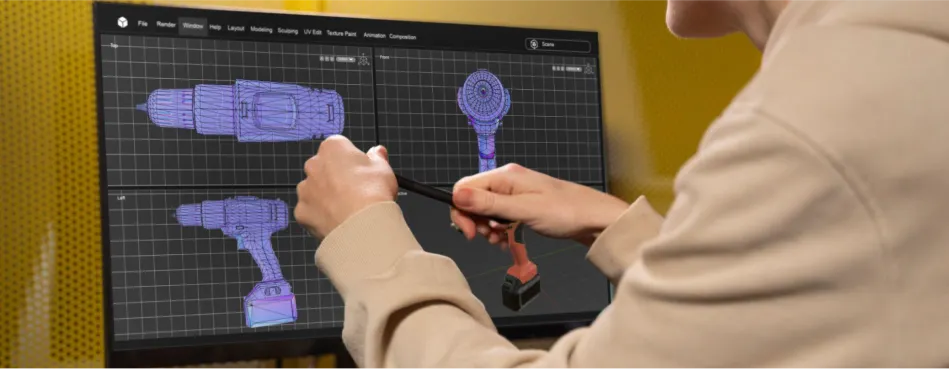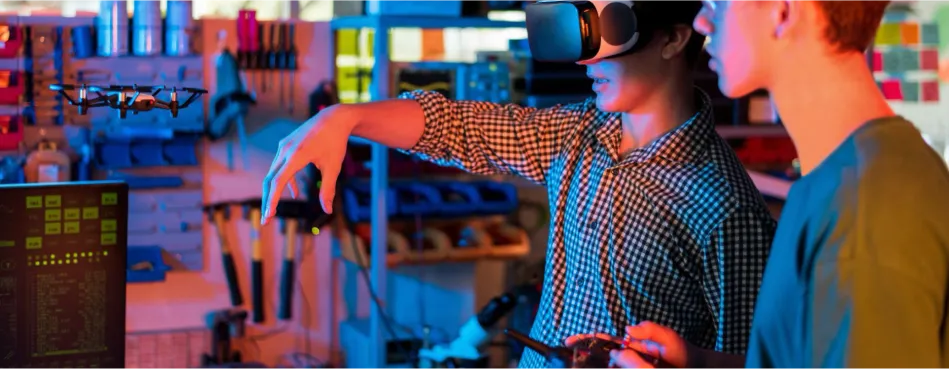
Artificial Intelligence (AI) has emerged as a groundbreaking force, revolutionizing various industries by enhancing efficiency, creativity, and innovation. From healthcare to finance, AI’s ability to process vast amounts of data and make intelligent decisions is transforming traditional processes and opening new possibilities.

In the realm of product development, AI’s impact is profound. By automating routine tasks, generating innovative design concepts, and predicting product performance, AI reshapes how products are conceived, designed, and brought to market. Integrating AI in product development offers numerous benefits, including accelerated design cycles, improved product quality, and personalized customer experiences. AI’s predictive capabilities enable designers to proactively foresee and address potential issues, ensuring higher reliability and customer satisfaction. Moreover, AI-driven insights facilitate the creation of sustainable and eco-friendly products by optimizing material usage and manufacturing processes.
Artificial Intelligence (AI) is the simulation of human intelligence in machines designed to think and act like humans. This encompasses various subfields, with machine learning (ML) being one of the most prominent. Machine learning involves using algorithms that enable computers to learn from data and improve their performance over time without being explicitly programmed.

In the context of product development, AI and ML have transformative applications that enhance every stage of the process. AI-driven tools can analyze vast datasets to identify trends and insights that inform product design and development. For instance, AI can generate multiple design concepts rapidly, providing designers with a broad range of innovative ideas. This capability accelerates the brainstorming phase, allowing for more creativity and experimentation.
Moreover, AI enhances product development efficiency by optimizing design parameters and predicting performance outcomes. By simulating different scenarios, AI tools help designers identify the best solutions early in development, reducing the need for costly and time-consuming iterations. Powered by AI, predictive analytics can forecast potential product failures and suggest preventive measures, improving product reliability and longevity.
AI also plays a crucial role in personalizing products to meet user needs. AI can tailor product features and functionalities by analyzing user data to create customized experiences that resonate with specific customer segments. This level of personalization is precious in industries such as consumer electronics and healthcare, where user preferences and requirements vary widely.
Furthermore, AI contributes to sustainable product development by optimizing material usage and manufacturing processes. This leads to the creation of eco-friendly products that minimize environmental impact. AI’s applications in product development are vast and varied, offering significant benefits in creativity, efficiency, personalization, and sustainability.
This introduction sets the stage for a comprehensive exploration of innovative strategies in healthcare product design, highlighting key themes and the importance of user-centered, technology-integrated, and empowering design approaches.
Artificial Intelligence (AI) is revolutionizing the creative process in product development by generating multiple design concepts quickly and efficiently. AI-driven tools use algorithms to analyze vast datasets and identify patterns, enabling them to produce a wide array of design options that might not be immediately apparent to human designers. This ability to explore numerous possibilities quickly accelerates the ideation phase, allowing for greater creativity and experimentation.

AI tools utilize generative design and evolutionary algorithms to create innovative design concepts. Generative design involves inputting design parameters and constraints into an AI system, generating numerous design alternatives that meet the specified criteria. These tools can also simulate different scenarios to assess the feasibility and performance of each design, helping designers select the best options.
1. Airbus and Autodesk: Airbus collaborated with Autodesk to use generative design to create a new aircraft partition. The AI-driven process explored many design possibilities, producing a lightweight, robust, and aerodynamically efficient partition. This innovative approach saved material costs and enhanced the aircraft’s fuel efficiency.
2. Under Armour and AI Design: Under Armour used AI to develop its innovative “Architech” line of shoes. By leveraging generative design algorithms, the company created a 3D-printed midsole that provides optimal support and cushioning. The AI-generated designs enabled Under Armour to push the boundaries of traditional shoe design and offer unique, high-performance products.
3. Nike and AI Creativity: Nike employs AI tools to design and customize shoes. Using machine learning algorithms, Nike analyzes customer data to identify emerging trends and preferences. This allows the company to create personalized and innovative designs that resonate with its audience, enhancing customer satisfaction and brand loyalty.
In summary, AI’s ability to quickly generate diverse design concepts fosters creativity and innovation in product development. By integrating AI into the design process, companies can explore various possibilities, optimize designs for performance and sustainability, and ultimately deliver groundbreaking products that meet evolving market demands.
AI is pivotal in enhancing efficiency and expediting the time-to-market for new products by optimizing design parameters and predicting performance outcomes. By leveraging AI algorithms, product developers can analyze vast datasets to identify optimal design configurations and foresee potential issues before they arise.

AI tools such as generative design algorithms help create numerous design variations based on specified parameters and constraints. These tools evaluate design configurations and optimize for material usage, structural integrity, and manufacturability. By automating this process, AI reduces the need for iterative testing and manual adjustments, significantly speeding up the design phase.
AI can simulate various real-world scenarios to predict a product’s performance under different conditions. Machine learning models can analyze historical data and identify patterns that indicate potential failures or performance issues. This predictive capability allows designers to address problems early in development, enhancing product reliability and reducing costly post-launch modifications.
1. Autodesk’s Generative Design: Autodesk’s generative design software enables designers to input design goals and constraints, and AI generates many design alternatives. This tool has been used in the aerospace and automotive industries, helping companies create innovative and efficient products faster.
2. Siemens’ Simcenter: Siemens’ Simcenter leverages AI and machine learning to predict product performance through advanced simulations. It helps engineers validate designs quickly and accurately, reducing the time required for physical testing.
3. ANSYS’ Discovery Live: ANSYS Discovery Live provides real-time simulation capabilities powered by AI. It allows engineers to interactively explore different design options and see instant feedback on performance, facilitating rapid design iteration and optimization.
By incorporating these AI tools into product development, companies can streamline workflows, enhance product quality, and rapidly bring innovations to market. The ability to optimize designs and predict outcomes early in the development cycle not only improves efficiency but also ensures that products meet the high standards expected by consumers.
Predictive maintenance involves using AI and machine learning algorithms to analyze data from sensors and other monitoring devices embedded in products and equipment. These AI systems monitor the condition and performance of the machinery in real-time, identifying patterns and anomalies that indicate potential issues. By analyzing historical and real-time data, AI can predict when a component will likely fail, allowing maintenance to be performed just in time to prevent unexpected breakdowns.

1. Increased Uptime: By predicting failures before they occur, AI ensures that maintenance can be scheduled during planned downtimes rather than unexpected breakdowns. This minimizes disruptions and keeps equipment running smoothly.
2. Cost Savings: Predictive maintenance reduces the need for reactive maintenance, which can be more costly due to emergency repairs and potential damage caused by sudden failures. By addressing issues before they escalate, companies save on maintenance costs and extend the lifespan of their equipment.
3. Enhanced Safety: Predictive maintenance improves safety by identifying potential hazards before accidents occur. For example, AI can detect wear and tear in critical machinery components, prompting timely replacements or repairs and preventing hazardous malfunctions.
4. Optimized Maintenance Schedules: AI creates more efficient maintenance schedules based on actual equipment conditions rather than fixed intervals. This ensures that maintenance efforts are focused on areas that need attention rather than wasting resources on unnecessary checks.
Incorporating AI for predictive maintenance enhances product reliability and safety and delivers significant cost savings and operational efficiencies, making it an invaluable strategy for modern product development.
AI has revolutionized the ability to personalize and customize products by analyzing vast user data to identify specific preferences, behaviors, and needs. Machine learning algorithms can sift through this data to uncover patterns and insights that inform design decisions, enabling the creation of products tailored to individual users. This process involves collecting data from various sources, such as user interactions, feedback, and usage patterns, which AI then uses to predict and fulfill user requirements.

For instance, in the fashion industry, AI can analyze customer browsing history, purchase behavior, and social media activity to recommend personalized clothing styles. AI can tailor medical treatments to individual patient profiles in healthcare, improving efficacy and patient satisfaction.
1. Nike and AI-Driven Customization:
Nike has leveraged AI to create the Nike Fit app, which uses machine learning to recommend the perfect shoe size for each customer. By scanning the user’s feet with a smartphone camera, the app collects data on foot dimensions and shape. AI algorithms then process this data to suggest the best-fitting shoes, ensuring each customer’s personalized and comfortable experience.
2. Spotify and Personalized Music Recommendations:
Spotify utilizes AI and machine learning to analyze users’ listening habits and preferences. The platform’s algorithms process this data to generate personalized playlists and music recommendations, enhancing user engagement and satisfaction. Features like Discover Weekly and Daily Mixes are prime examples of how AI-driven personalization can create a unique experience for each listener.
3. Procter & Gamble’s Olay Skin Advisor:
Olay, a leading skincare brand, developed the Olay Skin Advisor, an AI-powered tool that provides personalized skincare recommendations. Users upload a selfie, and the AI analyzes their skin condition, identifying wrinkles, dark spots, and texture issues. Based on this analysis, the tool recommends customized Olay products to address the user’s specific skincare needs, enhancing the personalization of their skincare routine.
AI’s ability to harness user data for personalization and customization is transforming various industries. It enables companies to deliver products and services that resonate deeply with individual preferences and enhance customer satisfaction.
AI’s Contribution to Optimizing Material Usage and Minimizing Waste:
Artificial Intelligence (AI) is crucial in promoting sustainability by optimizing material usage and minimizing waste throughout product development. AI algorithms analyze production data, supply chain logistics, and material properties to recommend the most efficient use of resources. AI reduces excess consumption and waste by predicting the optimal combination of materials and manufacturing techniques. Additionally, AI can simulate and predict the environmental impact of various design choices, enabling companies to make more eco-friendly decisions from the outset.

1. Dell’s Closed-Loop Recycling Program: Dell utilizes AI to enhance its closed-loop recycling program, which involves recycling plastics from old electronics into new products. AI algorithms help optimize recycling, ensuring high-quality materials are recovered and reused efficiently. This approach reduces waste and lessens the need for virgin materials, contributing to a circular economy.
2. Patagonia’s Sustainable Supply Chain: Patagonia employs AI to optimize its supply chain for sustainability. AI analyzes material sourcing, production methods, and logistics data to minimize environmental impact. This includes selecting eco-friendly materials and ensuring efficient transportation routes, thereby reducing the carbon footprint associated with their products. AI-driven insights reinforce Patagonia’s commitment to sustainability and help make its operations more environmentally responsible.
3. Unilever’s Sustainable Agriculture: Unilever uses AI to promote sustainable agriculture practices. AI tools analyze farm data to optimize water usage, reduce chemical inputs, and improve crop yields. This approach helps Unilever source ingredients more sustainably, ensuring their products are produced with minimal environmental impact. The AI-driven insights support farmers in adopting practices that are better for the environment and more economically viable.
Incorporating AI into product design and manufacturing processes significantly enhances sustainability efforts. By optimizing material usage and minimizing waste, AI helps companies develop eco-friendly products that meet consumer demands and contribute to a healthier planet.

AI significantly enhances product development’s prototyping and testing phases by automating complex tasks, accelerating design iterations, and providing real-time feedback. AI-driven tools can quickly generate prototypes based on initial design parameters, allowing designers to explore various options rapidly. Additionally, AI can simulate numerous usage scenarios and stress tests, identifying potential issues early in the development cycle. This predictive capability ensures that only the most viable prototypes advance to the physical testing stage, saving time and resources.
1. SolidWorks with AI Integration:
SolidWorks, a leading 3D CAD design software, integrates AI to enhance the design and prototyping process. AI capabilities in SolidWorks assist in design optimization, generating multiple design alternatives, and providing insights into potential improvements. This accelerates the prototyping phase, allowing designers to iterate and refine their concepts quickly.
2. Siemens NX:
Siemens NX is a comprehensive design and manufacturing solution that employs AI for predictive engineering and rapid prototyping. The software’s advanced simulation tools use AI to predict product behavior under various conditions, facilitating faster and more accurate prototyping. This helps identify design flaws and make necessary adjustments before creating physical prototypes
3. ANSYS Discovery Live:
ANSYS Discovery Live leverages AI to provide real-time simulation capabilities. Designers can interact with their models and see instant feedback on performance metrics, such as structural integrity, thermal response, and fluid dynamics. This immediate insight allows quick iterations and improvements, significantly speeding up the prototyping process.
By incorporating AI-powered tools and technologies, companies can enhance their prototyping and testing processes, resulting in more innovative, reliable, and market-ready products. The ability to rapidly iterate and optimize designs reduces development time and costs and ensures higher quality and better-performing products.
In-depth Analysis of Companies Successfully Integrating AI in Product Development:
AI transforms product development across various industries by enhancing design, optimizing processes, and improving overall product performance. Here are three compelling examples from automotive, healthcare, and consumer electronics.

BMW’s AI-Driven Production: BMW leverages AI to optimize its production processes and design new vehicle models. AI algorithms analyze design simulations and manufacturing process data to improve efficiency and reduce defects. For instance, BMW’s AI-based quality control systems detect imperfections in car bodies during assembly, ensuring higher quality and consistency. The company’s use of AI in predictive maintenance also helps anticipate potential equipment failures, minimizing downtime and enhancing overall production efficiency.

Philips IntelliVue Guardian Solution: Philips integrates AI into its IntelliVue Guardian Solution to enhance patient monitoring and care. This AI-powered system continuously analyzes patient data to predict and prevent health deterioration. Using machine learning algorithms, the solution identifies subtle changes in vital signs and alerts healthcare providers to potential issues before they become critical. This proactive approach to patient care improves outcomes and reduces the burden on medical staff, allowing for more efficient use of resources.

Dyson’s AI-Powered Vacuum Cleaners: Dyson employs AI to develop its advanced vacuum cleaners, such as the Dyson 360 Heurist. This robotic vacuum uses AI algorithms to map and navigate rooms efficiently, adapting to different surfaces and obstacles. The AI system learns from user interactions and environmental changes, continuously improving its cleaning performance. By incorporating AI, Dyson enhances the usability and effectiveness of its products, offering consumers a more convenient and efficient cleaning solution.
These case studies demonstrate the significant impact of AI on product development across diverse industries. By integrating AI, companies like BMW, Philips, and Dyson can innovate rapidly, improve product quality, and deliver superior customer experiences. AI-driven product development optimizes processes and enables the creation of more innovative, more efficient, and user-centric products.

Potential Challenges in Adopting AI for Product Development: Adopting AI in product development presents several challenges that organizations must navigate. One significant challenge is the high initial investment required for AI technologies, including software, hardware, and skilled personnel costs. Integrating AI into existing workflows can also be complex, requiring substantial changes to current processes and systems. Data quality and availability are also critical issues; AI systems rely on large, high-quality datasets to function effectively, and acquiring and managing this data can be difficult. Furthermore, there is a risk of over-reliance on AI, where companies may become too dependent on automated systems and overlook the importance of human expertise and intuition.
Ethical Considerations and Best Practices for AI Implementation: Implementing AI in product development raises several ethical considerations. One key concern is ensuring data privacy and security, as AI systems often require access to sensitive personal information. Organizations must implement robust data protection measures to safeguard user data and comply with relevant regulations. Another ethical issue is bias in AI algorithms, which can lead to unfair and discriminatory outcomes. It is crucial to regularly audit AI systems for bias and take corrective actions to ensure fairness and equity. Transparency is also essential; companies should be clear about how AI systems make decisions and provide understandable explanations to users.
Best Practices:
1. Start Small and Scale Gradually: Begin with pilot projects to test AI applications and demonstrate value before scaling up.
2. Invest in Talent: Hire or train personnel with AI and data science expertise to manage and implement AI systems effectively.
3. Ensure Data Quality: Establish robust data management practices to collect, clean, and maintain high-quality data.
4. Promote Collaboration: Encourage collaboration between AI experts and domain specialists to combine technical capabilities with industry knowledge.
5. Monitor and Improve: Continuously monitor AI systems for performance and ethical compliance, and be ready to make adjustments as needed.
By addressing these challenges and adhering to best practices, organizations can effectively harness the power of AI in product development while maintaining ethical standards and maximizing benefits.

Emerging Trends and Future Prospects of AI in Product Development: As AI technology advances, several emerging trends are set to shape the future of product development. One significant trend is the increased use of generative design, where AI algorithms generate various design options based on specific constraints and requirements. This approach allows for more innovative and optimized designs that human designers might need help to conceive. Additionally, AI-powered digital twins are becoming more prevalent. These virtual replicas of physical products or systems enable real-time monitoring and simulation, improving product performance and maintenance.
Predictions for the Next Decade:
1. Hyper-Personalization: AI will enable even greater levels of product personalization, tailoring products to individual consumer preferences and needs with unprecedented precision. This trend will be particularly impactful in consumer electronics, fashion, and healthcare.
2. Sustainability Focus: AI-driven innovations will be crucial in developing sustainable products. By optimizing material use and manufacturing processes, AI will help create eco-friendly products that reduce environmental impact.
3. Enhanced Collaboration Tools: AI will facilitate better collaboration among global teams through advanced communication and project management tools. These tools will leverage natural language processing (NLP) and machine learning to streamline workflows and improve productivity.
4. AI-Integrated Prototyping: The integration of AI in rapid prototyping will become more sophisticated, allowing for faster iterations and more accurate simulations. This will significantly shorten development cycles and reduce costs.
5. Advanced Predictive Analytics: AI will further enhance predictive analytics capabilities, providing deeper insights into market trends, consumer behavior, and potential product failures. This will enable companies to make data-driven decisions and stay ahead of the competition.
AI will continue revolutionizing product development in the next decade, driving innovation, efficiency, and sustainability. Companies that embrace these trends and invest in AI technologies will be well-positioned to lead in their respective markets.
AI’s transformative power in product development is undeniable. It enhances creativity by generating diverse design concepts, improves efficiency through optimized design parameters, and predicts performance outcomes. AI facilitates rapid prototyping, ensuring high-quality and reliable products. Additionally, AI enables personalized product designs, contributing to customer satisfaction and engagement. It also plays a crucial role in promoting sustainability by optimizing material usage and minimizing waste.
As we look to the future, AI will continue to drive innovation in product development, leading to hyper-personalized products, sustainable manufacturing practices, and advanced predictive analytics. Companies that embrace AI will benefit from improved efficiency, reduced time-to-market, and enhanced product quality.
Companies must adopt AI for product development to stay competitive and lead in their industries. By integrating AI technologies, businesses can unlock new levels of innovation and efficiency. Start exploring AI-driven tools and methodologies today to transform your product development processes and deliver superior products that meet evolving market demands.
Investing in AI is not just about keeping up with trends; it’s about positioning your company for future success. Embrace AI to enhance creativity, improve efficiency, ensure sustainability, and deliver products that resonate with customers. The future of product development is here—make AI an integral part of your strategy.